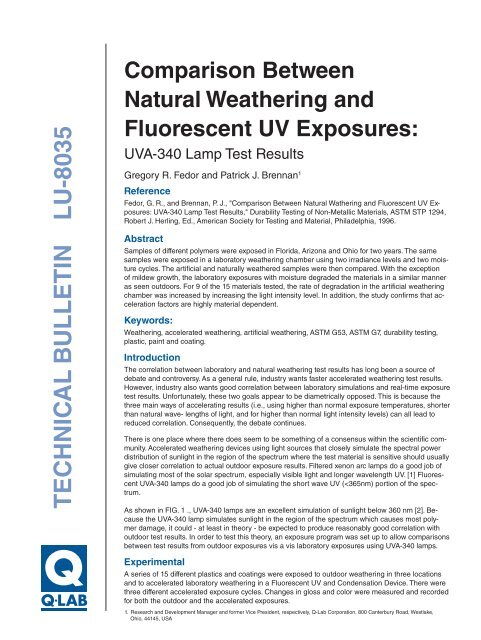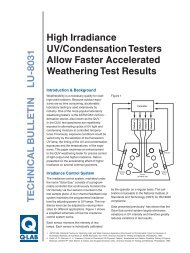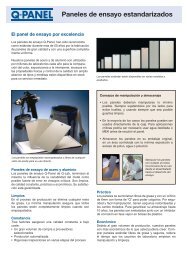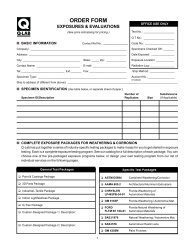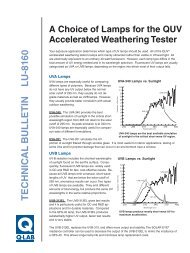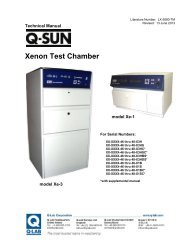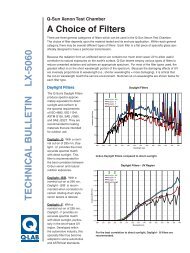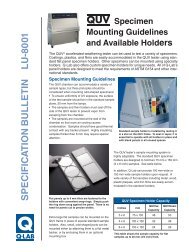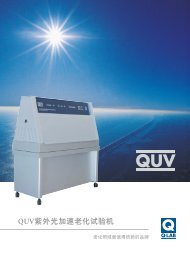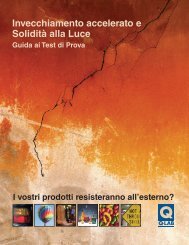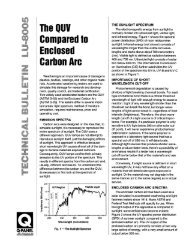TECHNIC AL B ULLETIN LU-8035 - Q-Lab
TECHNIC AL B ULLETIN LU-8035 - Q-Lab
TECHNIC AL B ULLETIN LU-8035 - Q-Lab
Create successful ePaper yourself
Turn your PDF publications into a flip-book with our unique Google optimized e-Paper software.
<strong>TECHNIC</strong><strong>AL</strong> B<strong>ULLETIN</strong> <strong>LU</strong>-<strong>8035</strong><br />
Comparison Between<br />
Natural Weathering and<br />
Fluorescent UV Exposures:<br />
UVA-340 Lamp Test Results<br />
Gregory R. Fedor and Patrick J. Brennan 1<br />
Reference<br />
Fedor, G. R., and Brennan, P. J., "Comparison Between Natural Wathering and Fluorescent UV Exposures:<br />
UVA-340 Lamp Test Results," Durability Testing of Non-Metallic Materials, ASTM STP 1294,<br />
Robert J. Herling, Ed., American Society for Testing and Material, Philadelphia, 1996.<br />
Abstract<br />
Samples of different polymers were exposed in Florida, Arizona and Ohio for two years. The same<br />
samples were exposed in a laboratory weathering chamber using two irradiance levels and two moisture<br />
cycles. The artificial and naturally weathered samples were then compared. With the exception<br />
of mildew growth, the laboratory exposures with moisture degraded the materials in a similar manner<br />
as seen outdoors. For 9 of the 15 materials tested, the rate of degradation in the artificial weathering<br />
chamber was increased by increasing the light intensity level. In addition, the study confirms that acceleration<br />
factors are highly material dependent.<br />
Keywords:<br />
Weathering, accelerated weathering, artificial weathering, ASTM G53, ASTM G7, durability testing,<br />
plastic, paint and coating.<br />
Introduction<br />
The correlation between laboratory and natural weathering test results has long been a source of<br />
debate and controversy. As a general rule, industry wants faster accelerated weathering test results.<br />
However, industry also wants good correlation between laboratory simulations and real-time exposure<br />
test results. Unfortunately, these two goals appear to be diametrically opposed. This is because the<br />
three main ways of accelerating results (i.e., using higher than normal exposure temperatures, shorter<br />
than natural wave- lengths of light, and for higher than normal light intensity levels) can all lead to<br />
reduced correlation. Consequently, the debate continues.<br />
There is one place where there does seem to be something of a consensus within the scientific community.<br />
Accelerated weathering devices using light sources that closely simulate the spectral power<br />
distribution of sunlight in the region of the spectrum where the test material is sensitive should usually<br />
give closer correlation to actual outdoor exposure results. Filtered xenon arc lamps do a good job of<br />
simulating most of the solar spectrum, especially visible light and longer wavelength UV. [1] Fluorescent<br />
UVA-340 lamps do a good job of simulating the short wave UV (
Outdoor Exposures. It is axiomatic that the<br />
forces that caused he type of product degradation<br />
commonly called "weathering" will vary greatly<br />
from place to place throughout the world. In order<br />
to characterize "outdoor weathering" in this study,<br />
three outdoor locations were chosen: a subtropical<br />
climate, a desert climate, and a northern<br />
industrial climate.<br />
various common plastics and coatings. [3] They<br />
were mostly commercially available formulations<br />
and may or may not be representative of their<br />
generic type.<br />
2<br />
Figure 1 - UVA-340 Lamp Compared to Sunlight 2<br />
Miami, Florida was chosen for the subtropical exposure<br />
because it has high intensity sunlight, high<br />
annual UV, high year-round temperatures, high<br />
annual rainfall and high humidity. Because these<br />
Florida weather conditions are often considered<br />
something of a "worst case," Florida is often used<br />
as a benchmark location for outdoor weatherability<br />
testing.<br />
Phoenix, Arizona was chosen for the desert exposure<br />
because it too is considered a benchmark<br />
location due to high annual UV and high yearround<br />
temperatures.<br />
Cleveland, Ohio was chosen as the northern<br />
industrial exposure site because it is a north- ern<br />
US industrial city with a typical mixed industrial<br />
manufacturing environment. All of the outdoor exposures<br />
were conducted in accordance to ASTM<br />
G7, Standard Practice for Environmental Exposure<br />
Testing of Non-Metallic Materials. Test specimens<br />
were mounted over a 1.6 mm (0.25 inch) plywood<br />
backing. They were mounted at 45 degrees from<br />
the horizontal, facing south. 45 South was chosen<br />
because it is commonly regarded as the typical<br />
exposure angle and is the angle of choice for<br />
many industries. It is the most widely used tilt<br />
angle for materials that do not have a specific enduse<br />
angle.<br />
Materials Tested. The materials used for these<br />
exposures were the same as used in a previous<br />
study which attempted to quantify the effects of<br />
high irradiance on the speed of degradation for<br />
2. Noon, midsummer sunlight (June 21, 1986), Cleveland Ohio, USA.<br />
3. Manufactured by Q-<strong>Lab</strong> Corporation, Westlake, Ohio, USA<br />
Accelerated Exposures. All of the laboratory<br />
exposures were performed in conformance with<br />
ASTM G53, Standard Practice for Operating Light<br />
and Water Exposure Apparatus (Fluorescent<br />
UV-Condensation Type) for Exposure of Nonmetallic<br />
Materials in a model QUV ® /se 3 which allows<br />
adjustment and feed-back-loop control of the UV<br />
light intensity. The lamps were UVA-340 lamps<br />
with a peak at 343 nm and a cut-on at 295 nm. A<br />
single exposure temperature (50C) was chosen to<br />
avoid confusion about any possible temperature<br />
effects. The laboratory exposure conditions were<br />
as follows:<br />
Cycle 1: 4 hours UV light alternating with 4 hours<br />
condensing moisture UVA-340 lamps operated at<br />
0.83 W/m 2 /nm @ 340 nm, 50 degrees C exposure<br />
temperature for both UV and condensation.<br />
The UV irradiance level used in this cycle is the<br />
same as that of a tester without irradiance control.<br />
It is approximately equivalent to noon summer<br />
sunlight at 340 nm.<br />
Cycle 2: 4 hours UV light alternating with 4 hours<br />
condensing moisture UVA-340 lamps operated at<br />
1.35 W/m 2 /nm @ 340 nm, 50 degrees C exposure<br />
temperature for both UV and condensation.<br />
This is the same as Cycle 1, except that the<br />
irradiance has been increased to determine if it<br />
would allow faster testing without affecting correlation.<br />
Cycle 3: UV-Only (100% UV light, no moisture, no<br />
dark time), UVA-340 lamps operated at 1.35 W/<br />
m 2 /m @ 340 nm, 50 degrees C exposure temperature.<br />
Evaluation of Degradation. The color and gloss<br />
of test specimens were measured in accordance<br />
with ASTM D2244, Standard Test Method for Calculation<br />
of Color Differences From Instrumentally
Measured Color Coordinates and D0523, Standard<br />
Test Method for Specular Gloss. Specimens<br />
exposed outdoors were measured after exposures<br />
of 12 months and 24 months. Specimens exposed<br />
in the 653 devices were measured at various<br />
intervals, depending on the material and the rate<br />
of change.<br />
Exposure Data<br />
PVC Film. This material was a clear unstabilized<br />
film. It was attached to a white painted aluminum<br />
panel using a pressure sensitive adhesive.<br />
Natural Weathering Results (FIG. 2). The material<br />
changed very little after two years in Ohio and<br />
Florida. In Arizona, the material turned slightly yellow<br />
after one year, and brown after two years. The<br />
rate of yellowing in Arizona was slow during the<br />
first year and fast during the second year.<br />
Accelerated Weathering Results (FIG. 3). The<br />
material changed very little after 2000 hours in a<br />
G53 device with a 4 hour UV / 4 hour moisture<br />
cycle, regardless of irradiance level. The material<br />
began to turn yellow after 1000 hours, and brown<br />
after 2000 hours, in a 653 device with continuous<br />
WV at an irradiance level of 1.35 W/m 2 .<br />
Comparison. The 653 with UV-Only Cycle agreed<br />
well with the Arizona exposures. No visible change<br />
was seen for quite awhile during both exposures<br />
and then, all of a sudden, the material turned yellow<br />
very rapidly. Apparently, the material required<br />
a certain amount of UV to initiate the yellowing<br />
process. Once this UV dosage was received, the<br />
yellowing was rapid. The point at which this happened<br />
was about 1200 hours. The point at which<br />
this happened in Arizona was about one year. No<br />
yellowing occurred in Florida, Ohio, or the exposure<br />
with the 4 hour UV / 4 hour moisture cycle.<br />
This was probably because the material had not<br />
yet received enough UV to initiate the yellowing<br />
process.<br />
Figure 3 - PVC Film, <strong>Lab</strong><br />
Blue Vinyl Film. This was an opaque, blue,<br />
glossy film. It was attached to an aluminum panel<br />
with a pressure sensitive adhesive.<br />
Natural Weathering Results (FIG. 4). The material<br />
went from shiny to nearly flat after two years in<br />
each of the three outdoor locations. Although the<br />
gloss loss was the same for the three locations,<br />
the samples are visually different from one another.<br />
The Ohio sample turned darker, the Arizona<br />
sample turned yellow, and the Florida sample<br />
stayed the same, other than the gloss loss.<br />
Accelerated Weathering Results (FIG. 5). The<br />
material went from a gloss of 75 to 55 after 2000<br />
hours for each of the G53 cycles. The sample<br />
exposed to UV-Only turned slightly yellow.<br />
Comparison. The G53 exposure produced the<br />
same gloss loss in 2000 hours as six months<br />
outdoors. This is the slowest acceleration rate of<br />
the 15 materials tested in this study. The yellowing<br />
seen in Arizona was also seen in the lab tester<br />
(with the UV-Only cycle) but this again was at a<br />
relatively slow acceleration rate.<br />
Figure 2 - PVC Film, Outdoors<br />
Figure 4 - Vinyl Film, Outdoors<br />
3
Figure 5 - Vinyl Film, <strong>Lab</strong><br />
Polystyrene Plaque. This was a clear plastic<br />
plaque 2.8mm thick. It is commonly used as a<br />
reference material for monitoring the UV dosage of<br />
accelerated weathering testers.<br />
Natural Weathering Results (FIG. 6). The material<br />
yellowed very quickly and severely in all three<br />
outdoor exposures. The rate and magnitude were<br />
nearly the same for all three locations.<br />
Accelerated Weathering Results (FIG. 7). The<br />
material yellowed quickly and severely in each of<br />
the laboratory exposures. The rate of yellowing<br />
was the fastest with the high irradiance UV-Only<br />
cycle, followed by the high irradiance 4 hours UV<br />
/ 4 hours moisture cycle, and then the normal<br />
irradiance 4 hours UV / 4 hours moisture cycle.<br />
The high irradiance UV-Only cycle also produced<br />
the most severe yellowing.<br />
Comparison. The exposure cycles with moisture<br />
agreed well with all three outdoor exposures. The<br />
magnitude of yellowing was about the same after<br />
2000 hours as 2 years outdoors. The cycle with<br />
UV-Only produced more extreme yellowing than<br />
outdoors.<br />
Figure 7 - Polystyrene, <strong>Lab</strong><br />
Green Vinyl Film. This was an opaque green<br />
film. It was attached to an aluminum panel with a<br />
pressure sensitive adhesive.<br />
Natural Weathering Results (FIG. 8). The material<br />
changed to a turquoise color after 2 years in<br />
each of the three outdoor locations. This color<br />
change was a shift in the blue direction, or a<br />
negative delta b*. The change was barely visible<br />
after one year, but was very obvious after 2 years.<br />
The majority of the change, therefore, occurred<br />
between the first and second years. The change<br />
was nearly identical for all three locations except<br />
that the Arizona and Ohio samples also turned<br />
darker for some unknown reason. The edges of<br />
the film also wrinkled and lifted off the aluminum<br />
panel.<br />
Accelerated Weathering Results (FIG. 9). The<br />
material turned slightly blue after 2000 hours in<br />
the cycles with moisture. There was no visible<br />
change in the UV-Only cycle.<br />
Comparison. The G53 cycles with moisture<br />
produced the same color change in 2000 hours<br />
as one year outdoors. The acceleration rate was<br />
the second slowest of the 15 materials studied.<br />
The edges of the film did not lift off the panel in<br />
the G53 device like they did outdoors, presumably<br />
because the edges were masked by the sample<br />
holder. To simulate this effect, the edges of the<br />
film should be exposed in the window area of the<br />
sample holder.<br />
4<br />
Figure 6 - Polystyrene, Outdoors
Comparison. The cycles with moisture agreed<br />
very well with the outdoor exposures in terns of<br />
gloss loss and chalking. The lab device, however,<br />
did not produce the rusting seen outdoors. The<br />
G53 device uses a pure water condensate and<br />
a more corrosive solution may be necessary to<br />
cause the rusting. This could probably be accomplished<br />
by a combined corrosion/weathering<br />
procedure, as reported elsewhere. [4] [5]<br />
Figure 8 - Vinyl Film, Outdoors<br />
Figure 10 - Epoxy, Outdoors<br />
Figure 9 - Vinyl Film, <strong>Lab</strong><br />
Epoxy Coating. This was a glossy, gray, coil<br />
coated primer on a steel substrate.<br />
Natural Weathering Results (FIG. 10). The material<br />
lost gloss and chalked very quickly in all three<br />
outdoor exposures. There was no measurable<br />
gloss after one year exposure. The panels also<br />
rusted in all three locations. The Florida samples<br />
were completely covered with rust and the Arizona<br />
and Ohio samples had partial rust.<br />
Accelerated Weathering Results (FIG. 11). The<br />
material lost gloss very quickly in all three cycles.<br />
The time to reach complete gloss loss was cut in<br />
half with the high irradiance cycles as compared<br />
to the normal irradiance cycle. The cycles with<br />
moisture produced chalking, whereas the UV-Only<br />
cycle did not.<br />
Figure 11 - Epoxy, <strong>Lab</strong><br />
Urethane Coating. This was a glossy gray coil<br />
coated primer over a steel substrate.<br />
Natural Weathering Results (FIG. 12). The material<br />
lost gloss in all three outdoor locations. The<br />
rate was the fastest in Florida and Arizona. After<br />
two years, however, the panels were flat in all<br />
three locations. The samples showed some chalking<br />
in all three locations. In addition, the Florida<br />
panels rusted on 20% of the surface, whereas<br />
the Ohio samples had a few rust spots, and the<br />
Arizona samples had no rust.<br />
5
Accelerated Weathering Results (FIG. 13). The<br />
material lost gloss and chalked very quickly in the<br />
cycles with moisture. The samples in the UV-Only<br />
cycle also lost gloss, but at a much slower rate<br />
and did not chalk.<br />
Comparison. The lab cycles with moisture<br />
agreed very well with the outdoor exposures in<br />
terms of gloss loss and chalking. However, the<br />
G53 device did not produce the rusting that was<br />
seen in Florida.<br />
Accelerated Weathering Results (FIG. 15).<br />
There was no visual change in this material in any<br />
of the three lab exposures. Gloss measurements<br />
show a slight gloss loss of a few percent.<br />
Comparison. Since there was no significant<br />
change in either the lab or outdoors, no useful<br />
comparison can be made.<br />
Figure 14 - Auto Coating, Outdoors<br />
Figure 12 - Urethane, Outdoors<br />
Figure 15 - Auto Coating, <strong>Lab</strong><br />
Figure 13 - Urethane, <strong>Lab</strong><br />
6<br />
Automotive Coating. This material was an exterior<br />
automotive top coat of unknown composition.<br />
It was a blue, high gloss finish and was applied to<br />
an aluminum panel.<br />
Natural Weathering Results (FIG. 14). There<br />
was no visual change in this material in any of the<br />
three outdoor exposures. Gloss loss was minimal.<br />
Polyester Coating. This was a medium gloss,<br />
tan, coil coated paint over aluminum.<br />
Natural Weathering Results (FIG. 16). The<br />
material lost gloss in all three of the outdoor<br />
exposures. The rate of gloss loss was fastest in<br />
Arizona, followed by Florida, and then Ohio. The<br />
amount of gloss loss after two years in Arizona<br />
and Florida was significant whereas it was only<br />
minor in Ohio.
Accelerated Weathering Results (FIG. 17). The<br />
material lost gloss in all three of the lab exposures.<br />
The gloss loss was significant in all three exposures<br />
but it was the fastest and most severe in the<br />
high irradiance 4 hour UV / 4 hour moisture cycle.<br />
Comparison. The G53 exposures agreed very<br />
well with the Florida and Arizona exposures. The<br />
2000 hour samples look similar to the two year<br />
Florida and Arizona samples. The lab results also<br />
agree with the Ohio exposures but at a higher<br />
acceleration rate since the gloss loss in Ohio is<br />
slower.<br />
Accelerated Weathering Results (FIG 19).<br />
There was no visual change in this material in any<br />
of the three exposures. Delta b* measurements<br />
show the material yellowed a very small amount.<br />
Comparison. The laboratory exposures agreed<br />
with the outdoor exposures. The UVA- 340 lamps<br />
produced no unnatural yellowing.<br />
Figure 18 - Acrylic, Outdoors<br />
Figure 16 - Polyester, Outdoors<br />
Figure 17 - Polyester, <strong>Lab</strong><br />
Acrylic Plaque. This was a commercially available<br />
clear sheet, 3.2m thick.<br />
Natural Weathering Results (FIG. 18). There<br />
was no visual change in this material in any of the<br />
three outdoor exposures. Delta b* measurements<br />
show the material yellowed a very small amount.<br />
Figure 19 - Acrylic, <strong>Lab</strong><br />
Polycarbonate Plaque. This was a commercially<br />
available clear sheet, 3.2rnm thick.<br />
Natural Weathering Results (FIG. 20). The material<br />
yellowed in each of the outdoor exposures.<br />
The rate of yellowing was faster in Florida and Arizona<br />
than it was in Ohio, but after two years, the<br />
amount of yellowing in Ohio caught up to Florida<br />
and Arizona.<br />
Accelerated Weathering Results (FIG 21). The<br />
material yellowed in each of the lab exposures.<br />
The rate of yellowing, however, was very different<br />
between the thee test cycles..The high irradiance<br />
UV-Only cycle was the fastest, followed by the<br />
7
high irradiance 4 hours UV / 4 hours moisture cycle,<br />
and then the normal irradiance 4 hours UV / 4<br />
hours moisture cycle. The high irradiance UV-Only<br />
cycle also produced the most severe yellowing.<br />
Comparison. The lab cycles with moisture agreed<br />
very well with all three outdoor exposures. The<br />
magnitude of yellowing was about the same after<br />
2000 hours as 2 years outdoors. The UV-Only<br />
cycle produced more extreme yellowing than was<br />
found outdoors.<br />
Accelerated Weathering Results (FIG 23).<br />
There was no visual change in this material in<br />
any of the three lab exposures. Delta b* measurements<br />
show the material changed color in the blue<br />
direction a very small amount.<br />
Comparison. The lab exposures agreed reasonably<br />
well with the outdoor exposures. Although the<br />
color measurement instruments can distinguish<br />
a difference, to the human eye, laboratory and<br />
outdoor exposures appear identical.<br />
Figure 20 - Polycarbonate, Outdoors<br />
Figure 22 - Polyethylene, Outdoors<br />
Figure 21 - Polycarbonate, <strong>Lab</strong><br />
Figure 23 - Polyethylene, <strong>Lab</strong><br />
8<br />
Polyethylene Plaque. This was a commercially<br />
available, ultra high molecular weight, white sheet,<br />
3.2m thick.<br />
Natural Weathering Results (FIG. 22). There<br />
was no visual change in this material in any of the<br />
three outdoor exposures. Delta b* measurements<br />
show the material yellowed a very small amount.<br />
ABS Plaque. This was a commercially available<br />
acrylonitrile-butadiene-styrene white opaque<br />
sheet, 3.2mm thick.<br />
Natural Weathering Results (FIG. 24). The<br />
material yellowed in each of the outdoor exposures.<br />
The rate of yellowing was somewhat faster<br />
in Arizona than it was in Florida and Ohio and the<br />
amount of yellowing after two years was slightly<br />
greater in Arizona.
Accelerated Weathering Results (FIG. 25). The<br />
material yellowed in each of the lab exposures.<br />
The UV-Only cycle produced the fastest and most<br />
severe yellowing.<br />
Comparison. The cycles with moisture agreed<br />
very well with all three outdoor exposures. The<br />
magnitude of yellowing was about the same after<br />
2000 hours as 2 years outdoors. The UV-Only<br />
cycle produced more extreme yellowing than found<br />
outdoors.<br />
Accelerated Weathering Results (FIG 27). The<br />
material turned noticeably yellow in each of the<br />
UVA-340 exposures. The rate of yellowing, however,<br />
was much faster in the UV- Only cycle and it<br />
also produced the most severe yellowing.<br />
Comparison. The UVA-340 exposures agreed<br />
very well with all three outdoor exposures. There<br />
were no visually significant differences in the<br />
amount of yellowing in any of the exposures.<br />
Figure 24 - ABS, Outdoors<br />
Figure 26 - CAB, Outdoors<br />
Figure 27 - CAB, <strong>Lab</strong><br />
Figure 25 - ABS, <strong>Lab</strong><br />
CAB Plaque. This cellulose acetate butyrate was<br />
a commercially available clear sheet, 3.2rnm thick.<br />
Natural Weathering Results (FIG. 26). The material<br />
turned noticeably yellow in each of the outdoor<br />
exposures. The rate of yellowing was faster in<br />
Florida and Arizona than it was in Ohio, but after<br />
two years, the amount of yellowing was about the<br />
same in Ohio as it was in Florida and Arizona.<br />
Polypropylene Plaque. Material was commercially<br />
available white sheet, 4.7m thick.<br />
Natural Weathering Results (FIG. 28). The<br />
material turned noticeably yellow after one year<br />
in each of the outdoor locations. The Arizona<br />
samples yellowed twice as much as the Florida<br />
and Ohio samples. After two years, however, the<br />
panels looked quite a bit different. The Ohio samples<br />
continued to yellow, the Florida samples grew<br />
mildew and turned very dark, and the Arizona<br />
samples turned much less yellow than they were<br />
after one year. In all three locations, the material<br />
9
degraded to the point where the surface could<br />
be easily scraped away with a fingernail, with the<br />
Arizona samples showing the most degradation.<br />
Accelerated Weathering Results (FIG 29). The<br />
material began to yellow in all three laboratory<br />
exposure cycles. The material continued to yellow<br />
in the UV-Only cycle for the entire 2000 hour exposure.<br />
In the two cycles with moisture, the material<br />
started to turn less yellow after about 700 hours<br />
and continued to do so for the remainder of the<br />
2000 hour exposure. The material also degraded<br />
to the point where the surface could be easily<br />
scraped away with a fingernail. This happened in<br />
all three cycles but more so for the high irradiance<br />
cycles.<br />
Comparison. The cycles with moisture agreed<br />
well with the outdoor exposures with the exception<br />
of the mildew growth on the Florida samples.<br />
The surface of the material degraded in the G53<br />
devices in the same fashion as in all the outdoor<br />
exposures. The samples exposed to moisture,<br />
also turned yellow and then reversed direction and<br />
became less yellow, just as they did in Arizona.<br />
Nylon Plaque. This was a commercially available,<br />
type 6/6, unpigmented sheet (light tan color),<br />
4.7mm thick.<br />
Natural Weathering Results (FIG. 30). The original<br />
color of the material was light tan and it turned<br />
lighter, or less yellow, during the Arizona and Ohio<br />
exposures. The Florida specimens began to turn<br />
yellow at first, but then started to grow mildew<br />
and turned darker. After two years, the material<br />
in all three locations degraded to the point where<br />
the surface could be easily scraped away with a<br />
fingernail.<br />
Accelerated Weathering Results (FIG. 31). The<br />
material turned lighter (less yellow) during the two<br />
cycles with moisture. The surface of the material<br />
degraded to the point where the surface could be<br />
easily scraped away with a fingernail. Conversely,<br />
with the UV-Only cycle, the material turned more<br />
yellow and the surface did not degrade to the<br />
point where it could be scraped away.<br />
Comparison. The cycles with moisture agreed<br />
very well with the outdoor exposures, with the<br />
exception of the mildew growth on the Florida<br />
samples. The samples in the lab became lighter<br />
in color and the surface of the material degraded<br />
the same as in all the outdoor exposures. The UV-<br />
Only cycle, however, did not agree very well with<br />
any of the outdoor exposures. This indicates that<br />
moisture is a critical parameter for this material<br />
and must be included in any accelerated test to<br />
simulate natural weathering.<br />
Figure 28 - Polypropylene Outdoors<br />
Figure 30 - Nylon Outdoors<br />
10<br />
Figure 29 - Polypropylene, <strong>Lab</strong>
The UV-Only cycle was proven to be a poor way to<br />
accelerate. This is in spite of the fact that the UV<br />
dosage was twice that of the cycles with moisture.<br />
The UV-Only cycle produced faster degradation on<br />
only 5 of the 15 materials. Surprisingly, it produced<br />
slower degradation on 3 of the 15. Therefore it<br />
seems reasonable to recommend that moisture<br />
be included in G53 exposure cycles for almost all<br />
materials.<br />
Conclusions<br />
Figure 31 - Nylon, <strong>Lab</strong><br />
Comparisons. Using UVA-340 lamps, the 653<br />
tester produced degradation consistent with that<br />
seen outdoors in all 15 of the materials tested. The<br />
only exception to this was that it could not reproduce<br />
the mildew growth and rusting that occurred<br />
outdoors.<br />
However, to obtain this high level of agreement,<br />
the exposure cycle must include moisture. When<br />
moisture was not included in the cycle, the mode<br />
of degradation did not agree with outdoors on 5 of<br />
the 15 materials. In addition, the degradation on 3<br />
of the other 15 materials was too severe. Therefore,<br />
when moisture was not included in the exposure,<br />
only 7 out of 15 materials agreed well with<br />
outdoors. When moisture was included in the test<br />
cycle, the 653 exposure agreed well with outdoors<br />
on 15 out of 15 materials.<br />
References<br />
[1] Brennan, P,, Fedor, C., "Sunlight, UV and Accelerated<br />
Weathering," SPE Automotive RETEC,<br />
1987.<br />
[2] Brennan, P., "Improved UV Light Source Enhances<br />
Correlation in Accelerated Weathering,"<br />
Plastics Compounding, March/April, 1987.<br />
[3] Fedor, 6. R., Brennan, P. J., ''Irradiance Control<br />
In Fluorescent UV Exposure Testers," Accelerated<br />
and Outdoor Durability Testing of Organic Materials,<br />
ASTM STP 1202, Warren D. Ketola, and Douglas<br />
Grossman, Eds., American Society for Testing<br />
and Materials, Philadelphia, 1993.<br />
[4] Skerry, B., Alavi, A., and Lindgren, K., "Environmental<br />
and Electrochemical Test Methods for the<br />
Evaluation of Protective Organic Coatings," Journal<br />
of Coatings Technology, October, 1988.<br />
D] Simpson, C., Ray, C., and Skerry, B., "Accelerated<br />
Corrosion Testing of Industrial Maintenance<br />
Paints Using a Cyclic Corrosion Weathering<br />
Method," Journal of Protective Coatings and Linings,<br />
May, 1991.<br />
In no case did the UVA-340 lamps produce any<br />
of the unnatural yellowing that has been reported<br />
from fluorescent UV-B lamp exposures.<br />
Acceleration. The study confirms that acceleration<br />
factors are highly material dependent. As a<br />
very rough measure, the degradation from the lab<br />
exposures averaged about 1000 hours to 1 year<br />
outdoors (9: 1 acceleration). However, there was<br />
a range of from 2: 1 to 35: 1. Obviously no single<br />
acceleration factor can be usefully applied to this<br />
data.<br />
Higher irradiance levels can speed up the test<br />
results on certain materials. High irradiance<br />
exposures gave faster test results than "normal"<br />
irradiance exposures on 9 of the 15 materials<br />
tested. In no case was agreement sacrificed due to<br />
high irradiance. No doubt this will not be true for all<br />
materials, but it was for the 15 tested in this study.<br />
11
Q-<strong>Lab</strong> Corporation<br />
Q-<strong>Lab</strong> Headquarters<br />
Westlake, OH USA<br />
Tel: +1-440-835-8700<br />
info@q-lab.com<br />
Q-<strong>Lab</strong> Florida<br />
Homestead, FL USA<br />
Tel: +1-305-245-5600<br />
q-lab@q-lab.com<br />
Q-<strong>Lab</strong> Europe, Ltd.<br />
Bolton, England<br />
Tel: +44-1204-861616<br />
info.eu@q-lab.com<br />
Q-<strong>Lab</strong> Arizona<br />
Buckeye, AZ USA<br />
Tel: +1-623-386-5140<br />
q-lab@q-lab.com<br />
www.q-lab.com<br />
Q-<strong>Lab</strong> Deutschland, GmbH<br />
Saarbrücken, Germany<br />
Tel: +49-681-857470<br />
vertrieb@q-lab.com<br />
Q-<strong>Lab</strong> China 中 国 代 表 处<br />
Shanghai, China 中 国 上 海<br />
电 话 : +86-21-5879-7970<br />
info.cn@q-lab.com<br />
<strong>LU</strong>-<strong>8035</strong>.1 © 2011 Q-<strong>Lab</strong> Corporation. All Rights Reserved.<br />
Q-<strong>Lab</strong>, the Q-<strong>Lab</strong> logo and QUV are registered trademarks of Q-<strong>Lab</strong> Corporation.


